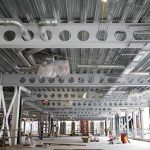- Post and Beam: When a vertical load weighs on a common post and beam structure, it is carried by a horizontal member and then shifted by bending to columns or vertical members. The beam is simply supported by its columns, sitting on top of them so that the ends of the beams can rotate on top of the columns with no restraint. The result is that the horizontal members of the structure then only carries axial forces.
- Rigid Frame: When a rigid frame structure is subjected to a vertical load, it is also picked up by the beams and eventually transferred through the columns to the ground. However, the joints are strongly connected, preventing any free rotation from occurring at the beams ends. This slight difference changes everything about the behavior of the beams, which is now the same as a fix-ended beam.
Rigid frame construction provides many benefits, such as decreased deflections, decreased internal bending moments, and increased rigidity. However, the columns are experiencing some degree of internal bending themselves as the beams stay rigid.
HOW IS IT DESIGNED?
The connections of the joints in rigid frame construction vary between being fully fixed-end, in which the connection offers full restraint and no ability to rotate and pin connection, where the members are completely free to rotate. This relationship is referred to the relative stiffness of the horizontal and vertical members.
From a designer’s perspective, a rigid frame structure can be designed smaller than other post and beam systems. This is because internal bending moments are reduced by the rigidity. On the other hand, the columns or vertical members should be designed to be a bit larger, since they are carrying both axial loads and internal bending moments.
MOMENT RESISTING CONNECTIONS
The so-called rigid connections are typically full depth end-plate connections and extended end-plate connections. The most common of these is the bolted end-plate beam-to-column connection. The selection depends on the budget.
Welded connections can be used in place of the bolted end-plate, especially in seismically active regions. Welded connections can provide full moment continuity but tend to be on the expensive side. If used, the welded connections should be prefabricated rather than welded on-site.


